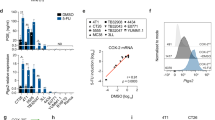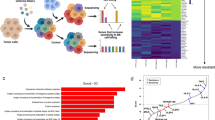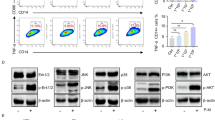Abstract
Previous studies have shown that the CC chemokine receptor CCR5 is downregulated on monocyte/macrophage (MO/Mφ) surfaces in head and neck squamous cell carcinoma (HNSCC) patients (stage IIIB). Ligands (RANTES, MIP-1α and MIP-1β) of this chemokine receptor were also secreted in lesser quantity from MO/Mφ of HNSCC patients in comparison with healthy individuals. In an aim to restore this dysregulated receptor–ligand signaling, we have used neem leaf glycoprotein (NLGP), a novel immunomodulator reported from our laboratory. NLGP upregulated CCR5 expression, as evidenced from studies on MO/Mφ of peripheral blood from HNSCC patients as well as healthy individuals. Expression of RANTES, MIP-1α and MIP-1β was also upregulated following NLGP treatment of these cells in vitro. Interestingly, NLGP has little effect on the expression of CCR5 and the ligand RANTES in oral cancer cells. This restored CCR5 receptor–ligand signaling seen in MO/Mφ was reflected in improved CCR5-dependent, p38 mitogen-activated protein kinase (MAPK)-mediated migration of MO/Mφ after NLGP treatment to a standard chemoattractant. NLGP also induces better antigen presentation and simultaneous costimulation to effector T cells by MO/Mφ by upregulating human leucocyte antigen (HLA)-ABC, CD80 and CD86. In addition, NLGP-treated MO/Mφ-primed T cells can effectively lyse tumor cells in vitro. The effects of NLGP on monocyte migration and T cell-mediated oral tumor cell killing were further demonstrated in transwell assays with or without CCR5 neutralization. These results suggest a new approach in cancer immunotherapy by modulating dysregulated CCR5 signals from MO/Mφ.
This is a preview of subscription content, access via your institution
Access options
Subscribe to this journal
Receive 12 digital issues and online access to articles
$119.00 per year
only $9.92 per issue
Buy this article
- Purchase on Springer Link
- Instant access to full article PDF
Prices may be subject to local taxes which are calculated during checkout











Similar content being viewed by others
References
Gough MJ, Alan A, Melcher M, Atique A, Marka RC, David S et al. Macrophages orchestrate the immune response to tumor cell death. Cancer Res 2001; 61: 7240–7247.
Croci DO, Zacarías Fluck MF, Rico MJ, Matar P, Rabinovich GA, Scharovsky OG et al. Dynamic cross-talk between tumor and immune cells in orchestrating the immunosuppressive network at the tumor microenvironment. Cancer Immunol Immunother 2007; 56: 1687–1700.
Moser B, Loetscher P . Lymphocyte traffic control by chemokines. Nat Immunol 2001; 2: 123–128.
Baggiolini M . Chemokines and leukocyte traffic. Nature 1998; 392: 565–568.
Goldberg-Bittman I, Neumark E, Sagi-Assif O, Azenshtein E, Meshel T, Witz IP et al. The expression of chemokine receptor CXCR3 and its ligand CXCL10, in human breast adenocarcinoma cell lines. Immunol Lett 2004; 92: 171–178.
Feferman T, Maiti PK, Berrih-Aknin S, Bismuth J, Bidault J, Fuchs S et al. Overexpression of IFN-induced protein 10 and its receptor CXCR3 in myasthenia gravis. J Immunol 2005; 174: 5324–5331.
Chakraborty K, Bose A, Pal S, Sarkar K, Goswami S, Chattopadhyay U et al. Neem leaf glycoprotein restores the impaired chemotactic activity of peripheral blood mononuclear cells from head and neck squamous cell carcinoma patients by maintaining CXCR3/CXCL10 balance. Int Immunopharmacol 2008; 8: 330–340.
Bose A, Chakraborty T, Chakraborty K, Pal S, Baral R . Dysregulation in immune functions is reflected in tumor cell cytotoxicity by peripheral blood mononuclear cells from head and neck squamous cell carcinoma patients. Cancer Immunity 2008; 8: 10.
Bose A, Baral RN . NK cellular cytotoxicity of tumor cells initiated by neem leaf preparation is associated with CD40–CD40L mediated endogenous production of interleukin-12. Human Immunol 2007; 68: 823–831.
Bose A, Chakraborty K, Sarkar K, Chakraborty T, Goswami S, Pal S et al. Neem leaf glycoprotein induces perforin mediated tumor cell killing by T and NK cells through differential regulation of IFNgamma signaling. J Immunother 2009; 32: 42–53.
Samson M, Labbe O, Mollereau C, Vassart G, Parmentier M . Molecular cloning and functional expression of a new human CC chemokine receptor gene. Biochemistry 1996; 35: 3362–3367.
Bleul CC, Wu L, Hoxie JA, Springer TA, Mackay CR . The HIV coreceptor CXCR4 and CCR5 are differentially expressed and regulated on human T lymphocytes. Proc Natl Acad Sci USA 1997; 94: 1925–1930.
Durig J, de Wynter EA, Kasper C, Cross MA, Chang J . Expression of macrophage inflammatory protein-1 receptor in human CD34(+) hematopoietic cells and their modulation by tumor necrosis factor-alpha and interferon-gamma. Blood 1998; 92: 3073–3081.
Wu L, Paxton WA, Kassam N, Ruffing N, Rottman JB, Sullivan N . CCR5 levels and expression pattern correlate with infectability by macrophage-topic HIV-1 in vitro. J Exp Med 1997; 185: 1681–1691.
Zaitseva M, Blauvelt A, Lee S, Lapham CK, Klaus-Kovtun V, Mostowski H . Expression and function of CCR5 and CXCR4 on human Langerhans cells and macrophages: implications for HIV primary infection. Nature Med 1997; 3: 1369–1375.
Qin S, Rottman JB, Myers P, Kassam N, Weinblatt M, Loetscher M . The chemokine receptors CXCR3 and CCR5 mark subsets of T cells associated with certain inflammatory reactions. J Clin Invest 1998; 101: 746–754.
Sarkar K, Bose A, Chakraborty K, Haque E, Ghosh D, Goswami S et al. Neem leaf glycoprotein helps to generate carcinoembryonic antigen specific anti-tumor immune responses utilizing macrophage-mediated antigen presentation. Vaccine 2008; 26: 4352–4362.
Baral RN, Chattopadhyay U . Neem (Azadirachta indica) leaf mediated immune activation causes prophylactic growth inhibition of murine Ehrlich carcinoma and B16 melanoma. Int Immunopharmacol 2004; 4: 355–366.
Baral RN, Sarkar K, Mandal-Ghosh I, Bose A . Relevance of neem leaf glycoprotein as a new vaccine adjuvant for cancer immunotherapy. In: Gupta VK (ed.) Researches in Bioactive Natural Products. Houston, TX:Studium Press LLC, in press
Lowry OH, Rosenbrough NJ, Farr AL, Randall RJ . Protein measurement with the Folin phenol reagent. J Biol Chem 1951; 193: 265–275.
Chakraborty K, Bose A, Pal S, Chattopadhyay U, Baral R . Interferon alpha2b restores the impaired chemotactic activity of peripheral blood mononuclear cells from head and neck squamous cell carcinoma patients by modulation CXC receptor ligand interaction. J Interferon Cytokine Res 2008; 28: 487–499.
Scaldaferri F, Sans M, Vetrano S, Correale AV, Pagano N, Rando G et al. The role of MAPK in governing lymphocyte adhesion to and migration across the microvasculature in inflammatory bowel disease. Eur J Immunol 2009; 39: 290–300.
Bose A, Chakraborty K, Sarkar K, Goswami S, Haque E, Chakraborty T et al. Neem leaf glycoprotein directs T-bet associated type 1 immune commitment. Hum Immunol 2009; 70: 6–15.
Lang S, Lauffer L, Clausen C, Löhr I, Schmitt B, Hölzel D et al. Impaired monocyte function in cancer patients: restoration with a cyclooxygenase-2 inhibitor. FASEB J 2003; 2: 286–288.
Chuang JY, Yang WH, Chen HT . CCL5/CCR5 axis promotes the motility of human oral cancer cells. J Cell Physiol 2009; 220: 418–426.
Bose A, Haque E, Baral RN . Neem leaf preparation induces apoptosis of tumor cells by releasing cytotoxic cytokines from human peripheral blood mononuclear cells. Phytother Res 2007; 21: 914–920.
Montecucco F, Steffens S, Burger F, Da Costa A, Bianchi G, Bertolotto M et al. Tumor necrosis factor-alpha (TNF-alpha) induces integrin CD11b/CD18 (Mac-1) up-regulation and migration to the CC chemokine CCL3 (MIP-1alpha) on human neutrophils through defined signalling pathways. Cell Signal 2008; 20: 557–568.
Lee HM, Kim HJ, Won KJ, Choia WS, Parka SH, Songb H et al. Soluble form of vascular cell adhesion molecule 1 induces migration and proliferation of vascular smooth muscle cells. J Vasc Res 2008; 45: 259–268.
Acknowledgements
Partial grant supports from the Indian Council of Medical Research, New Delhi (Grant Nos. 3/2/2/131/2007/NCD-III and Immuno/18/11/08/2006-ECD-I) and University Grant Commission, New Delhi (Grant No. F.2-3/2000 (SA-1) to AB and TC) are acknowledged. The authors thank Dr Jaydip Biswas, Director, CNCI, India, for providing necessary facilities. They also thank Dr Subrata Laskar, University of Burdwan, West Bengal, India, for his help in characterization of NLGP.
Author information
Authors and Affiliations
Rights and permissions
About this article
Cite this article
Chakraborty, K., Bose, A., Chakraborty, T. et al. Restoration of dysregulated CC chemokine signaling for monocyte/macrophage chemotaxis in head and neck squamous cell carcinoma patients by neem leaf glycoprotein maximizes tumor cell cytotoxicity. Cell Mol Immunol 7, 396–408 (2010). https://doi.org/10.1038/cmi.2010.29
Received:
Revised:
Accepted:
Published:
Issue Date:
DOI: https://doi.org/10.1038/cmi.2010.29
Keywords
This article is cited by
-
Exploring the role of Azadirachta indica (neem) and its active compounds in the regulation of biological pathways: an update on molecular approach
3 Biotech (2021)
-
NLGP counterbalances the immunosuppressive effect of tumor-associated mesenchymal stem cells to restore effector T cell functions
Stem Cell Research & Therapy (2019)
-
Towards Neuroimmunotherapy for Cancer: the Neurotransmitters Glutamate, Dopamine and GnRH-II augment substantially the ability of T cells of few Head and Neck cancer patients to perform spontaneous migration, chemotactic migration and migration towards the autologous tumor, and also elevate markedly the expression of CD3zeta and CD3epsilon TCR-associated chains
Journal of Neural Transmission (2014)



